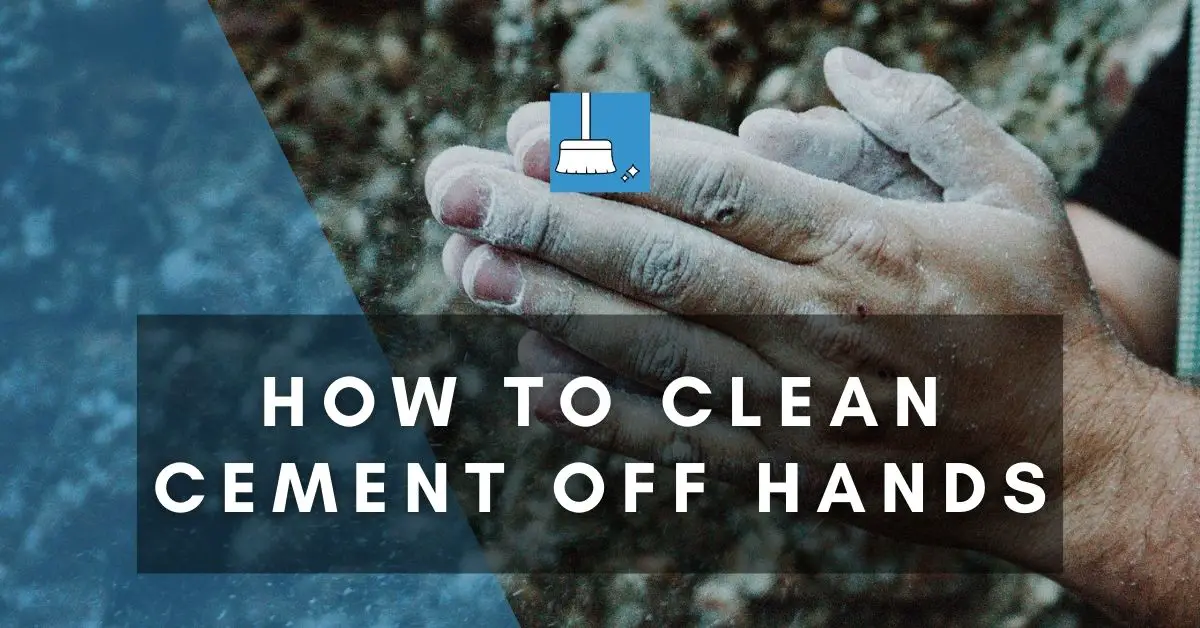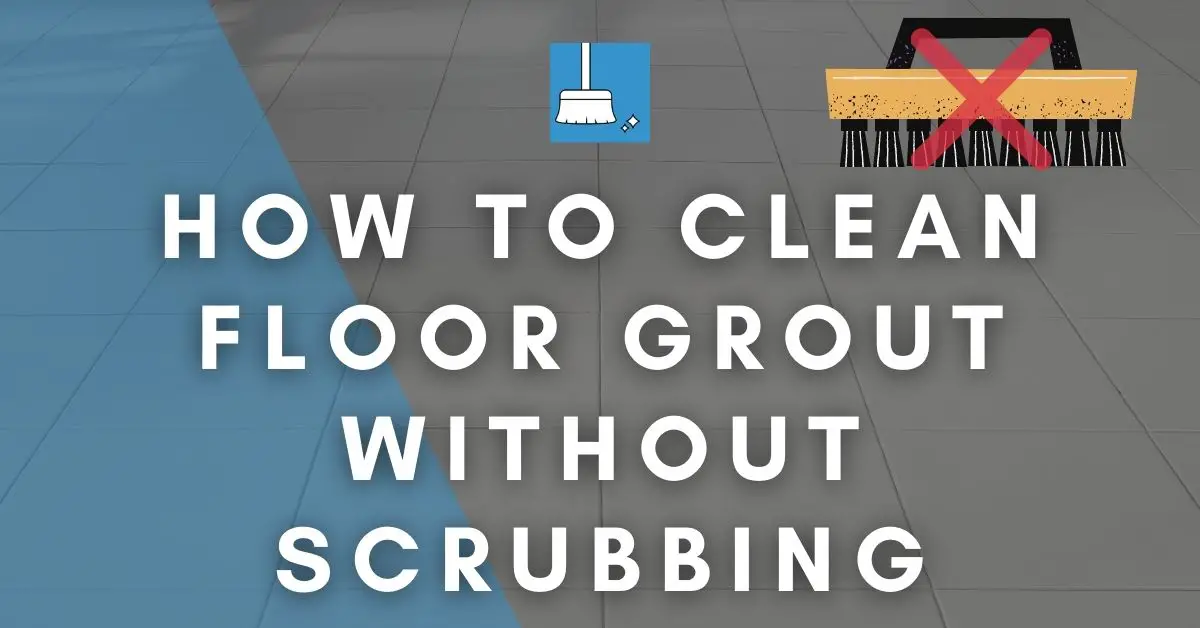Do you know that there are many different ways cement can find its way to your skin and your hands? Maybe you are a construction worker or a sculptor or just a regular person. It does not matter whether your daily activity involves the use of cement or not.
The ways cement can come in contact with your body include absentmindedly rubbing your hands or body against a newly cemented surface that is yet to dry, not wearing gloves while working with cement, etc.
If this happens, and you leave the cement on your body, and it dries off without you washing it off in the proper way, it may result in skin irritation because of the chemical composition of cement. Cement contains substances that raise their pH to about 12, while that of the skin is about 7.
This can be a cause for concern but don’t worry, YOU WILL BE SAVED.
How to Clean Cement off Your Hands (4 Methods)
Method 1: Removing Cement from Hands Using Water

This method (Also known as Hydrotherapy) is only applicable if there isnt too much cement on your hands or if the stain caused by the cement is minimal.
This process requires some time but you won’t have to use anything else than water. This method is helpful in slowing down the possible damage that cement may cause to your hand.
There is only one step that you need to follow:
STEP: Wash your hands with clean, warm water for about 30 minutes. While cleaning, gently rub your hands together to get rid of the cement.
You can also use a pH-neutral cleaner alongside the water if it is readily available.
Method 2: Removing Cement from Hands Using pH Neutral Soaps and Vinegar
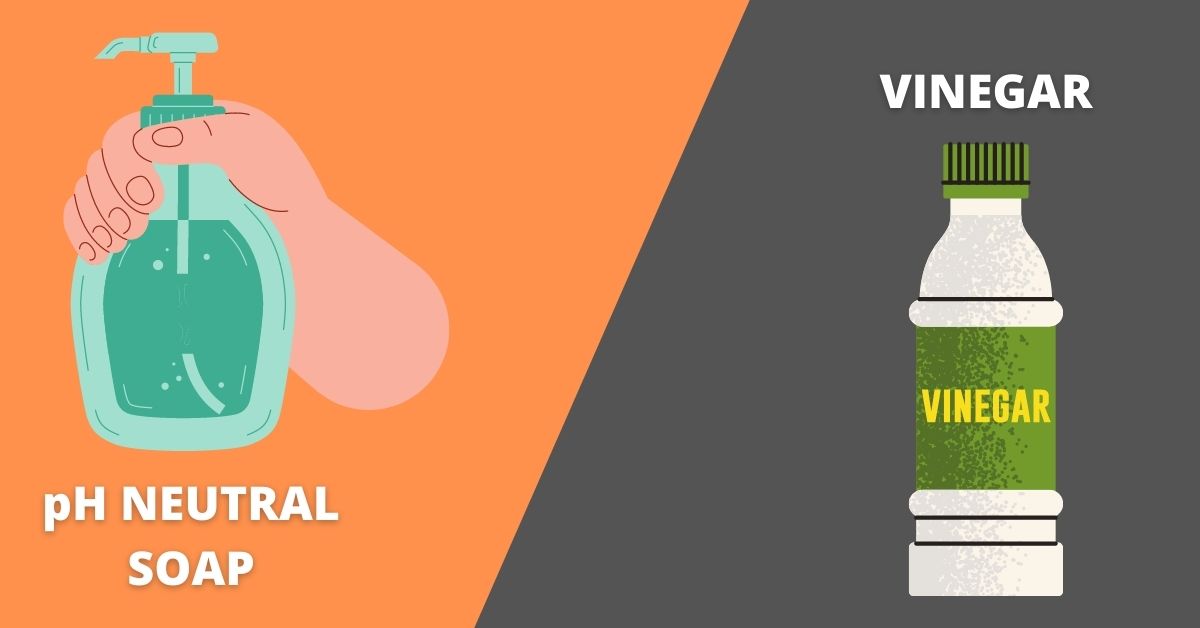
The pH of cement is about 12. What this means is that cement has high alkalinity, and when trying to clean cement off your hands, you must ensure that the soap you want to use is pH neutral.
Vinegar is also efficient because of its acidic nature (Acetic Acid) that counters the alkaline effects of the cement.
YOU’LL NEED
1- Running water
2- pH netural soap
3- White vinegar
4- Towel
STEPS
STEP 1: Rinse your hand thoroughly with water. You can put your hand under a tap of water and rub it together while the water runs over. This helps to dissolve the cement.
STEP 2: Proceed to use the soap to wash your hands. Pay attention to the stubborn stains and rub them extra hard.
STEP 3: Rinse your hands afterward with water.
STEP 4: Cement residue may still be on your hand after the cleaning process. This is where vinegar comes in. Pour some white vinegar on your hands and rub them together to allow it to spread.
STEP 5: Repeat the process about two times, and rinse your hands with water afterward.
STEP 6: Dry your hand with a towel in a very gentle manner to avoid bruising.
Here is a pH netural soap that you can consider having a look at.
Method 3: Removing Cement from Hands Using Pumice Stone
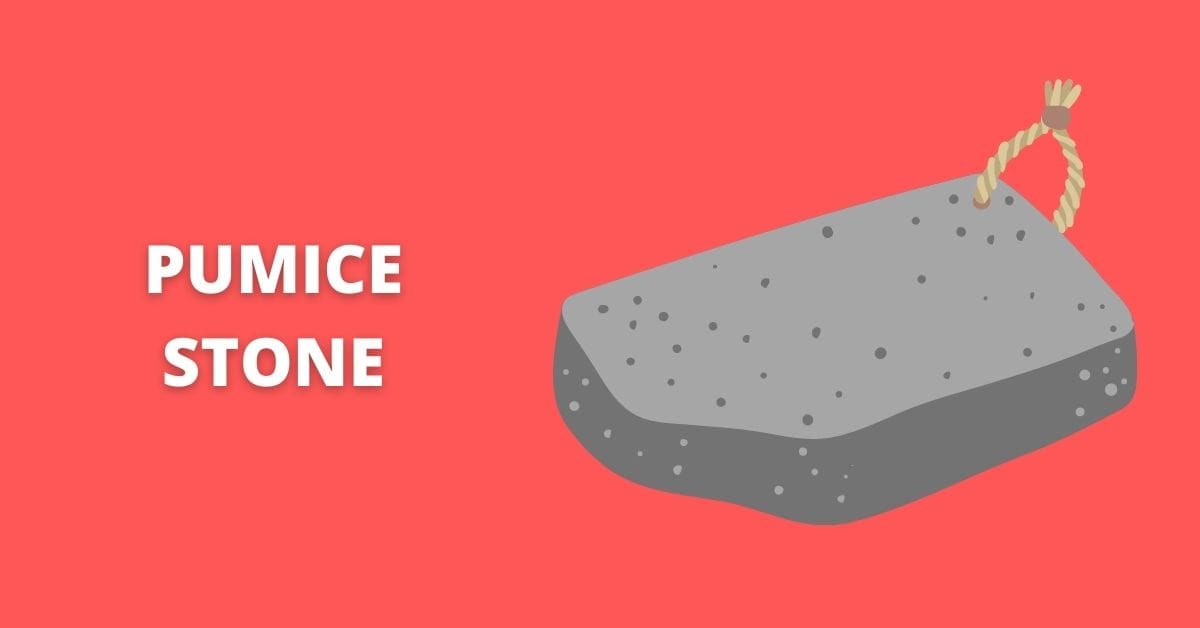
If you have fragile or sensitive skin, it is advisable that you try this method with caution or not even try it at all to be on the safe side.
Pumice stone is a very light stone that is formed from the natural mixture of lava and water. It can also be used for getting rid of cement from your hands.
YOU’LL NEED
1- Bowl
2- Warm water
3- Pumice stone
STEPS
STEP 1: Put the pumice stone in a bowl of warm water.
STEP 2: Immerse the affected hand in the water for about 15 minutes to get rid of excess cement.
STEP 3: Use the stone to scrub the cement stain away from the hand gently. You should be careful at this stage to avoid the stone from bruising your skin.
STEP 4: You should notice some or all of the cement coming off. Repeat the process until all cement has been removed.
STEP 5: Rinse your hand with clean water afterward.
It is a good practice to have a good Pumice stone in your home for many household cleaning purposes and also your feet heels and palm.
Method 4: Removing Cement from Hands Using Lemon Juice and Toothbrush

Lemon Juice is another excellent cleaning solution that you can use to clean cement off your hands. Due to the presence of citric acid in Lemon, it can easily counteract the effects of the cement and prevent any damage to your hand.
YOU’LL NEED
1- Lemon Juice
2- Warm water
3- Toothbrush
4- Dry cloth
STEPS
STEP 1: Rinse the affected hand with warm water and try to scrub as much excess cement away as possible.
STEP 2: Mix an equal amount of lemon juice and water in a bowl and dip your hand in the bowl for about 10 minutes.
STEP 3: Use a toothbrush to scrub your hand with it, especially the palm lines.
STEP 4: Repeat this process until all of the cement is cleaned off. Dry your hand with a clean, dry cloth.
How to Clean PVC Cement off Your Hands
When you hear cement, the first image that comes to your mind may likely be a soft sandy substance and not some chemical solvent that looks more like glue. PVC cement is an adhesive used for binding pipes to each other.
When PVC cement gets on your hand or skin, here is a way to remove it:
Removing PVC Cement from Hands Using Acetone / Nail Polish Remover
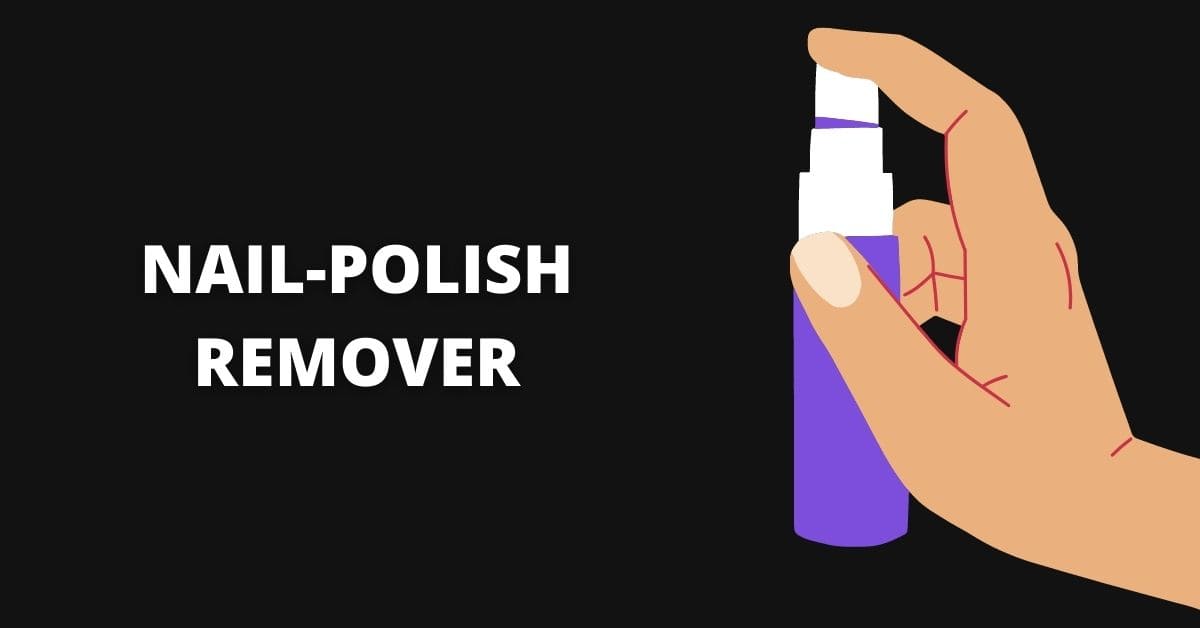
Acetone is a substance present in nail polish removers, it is efficient in dissolving adhesives, and you can also use it to clean PVC cement from your hands.
STEP 1: Submerge your hand in a solution of warm water and an antiseptic soap to dissolve some of the PVC cement.
STEP 2: pour some acetone into a small bowl and use a cotton ball to apply it to the parts of the hands that are stained with the cement.
STEP 3: Keep applying acetone to the area by continuously rubbing the cotton ball on your hands. Replace cotton (with a new one) as and when required.
STEP 4: This should dissolve the PVC cement quickly. You can rub your fingers together to remove the peeled-off cement.
STEP 5: After the process is completed and there are no visible cement stains, wash your hands with water and soap to eliminate any residue of glue and acetone.
This method can also be used for cleaning rubber cement and contact cement off brushes and hands.
Alternate Method: Using Vinegar
If you do not have a nail polish remover or acetone available, white vinegar can also be used solely for the same purpose.
STEP 1: After rinsing your hand with water, apply white vinegar and leave it for about fifteen minutes.
STEP 2: Rinse afterward with water and dry with a towel.
How to Clean Rubber Cement and Contact Cement off Your Hands
Rubber cement is another adhesive used alongside solvents like acetone to obtain a liquid that can further adhere any material to another.
Contact cement is also popularly known as a contact adhesive. It is similar to rubber cement; the only difference is that the materials bonded by contact cement are more permanently bonded than those bonded with rubber cement.
While working with either of these two adhesives, it may get on your hands if you do not take the necessary precautions. When this happens, here are the ways to clean it off your hands.

Mineral spirits are organic solvents that are effective in removing oil-based stains, grease stains that cannot be easily cleaned with water. Check Mineral spirits here.
YOU’LL NEED
1- Clean cloth
2- Mineral spirits
STEPS
STEP 1: Damp a clean cloth with mineral spirits. If you pour mineral spirits directly on your hands, you may end up wasting a lot of it.
STEP 2: Place the damp cloth on your hand for about 45 minutes to one hour, depending on the amount of rubber cement on your hand.
This would help to dissolve the rubber cement. You can also use the cloth to scrub your hand gently.
STEP 3: Afterwards, remove the cloth and rinse your hand with clean water.
Method 2: Removing Rubber/Contact Cement from Hands Using Natural Oils

If, after trying to clean your hands with just water, and there are still residues of cement, natural oils like coconut oil or butter oil can also come in handy.
YOU’LL NEED
1- Clean cloth
2- Natural oil
3- Soap
STEPS
STEP 1: After soaking your hands with water and rinsing thoroughly, use a clean cloth to dry them.
STEP 2: Gently apply any of the natural oils you want to use on the affected area of your hand.
STEP 3: Rub the oil into the stain by massaging it with your hand.
STEP 4: If the cement begins to peel off, continue to massage your hand with the oil; otherwise, leave the oil on the affected area for about 30 minutes. The cement should come after 30 minutes.
STEP 5: Wash your hands afterward with soap and water to get rid of the residue of oil and cement.
How to Prevent Contact With Cement?
It is possible for your skin to still come in contact with cement even after using the necessary protective gear. This can happen when you do not carefully remove the gloves or when you wear protective gear that is loose.
The United States Department of Labor has an extensive resource here that explains the safety practices for using cement. Some of these are:
1- Always wear gloves and other safety gear that fits you perfectly.
2- Ensure that the boots you use are waterproof.
3- Wear the necessary eye protection gear.
4- Wash your hands before and after putting on gloves.
5- Inspect gloves and ensure that there are no holes before wearing them.
6- Follow instructions on how to remove used gloves from your hands safely.
7- When you want to remove gloves, wash the outside part with clean water so that you can easily use each hand to remove the glove from the other hand.
One of the easiest ways to avoid cement from coming in contact with your skin is by wearing protective gear like long sleeve coats, helmets, and boots whenever you are in an area where cement is being used, whether or not you are the one working with the cement.
Is Cement Harmful to the Skin?
Yes, cement is harmful to your skin because of its chemical composition. The pH of cement is 12, while that of an average skin is 7. This means that cement is very alkaline, which also makes it very abrasive. Leaving cement for too long on your skin after contact can cause severe damages to your skin.
Generally, it takes about 2-4 days for the cement to dry on a hard surface, depending on temperature and moisture. However, it takes lesser time to dry when it is on the skin. If your skin comes in contact with cement, it takes about 20-30 minutes to get dry and become slightly stiff.
Leaving cement on the skin for long can result in Skin burn, Skin Irritation (i.e. swollen skin or redness around the affected area, Dermatitis (also known as inflammation of the skin, is characterized by swelling, blusters, and other abnormal skin conditions), etc. (source)
Conclusion
Whether it is regular cement or concrete that you come in contact with and stain your hands, or it is adhesives like rubber cement or contact cement, the proven methods have been covered in this article.
I hope this guide was of help to you.
Cheers!

